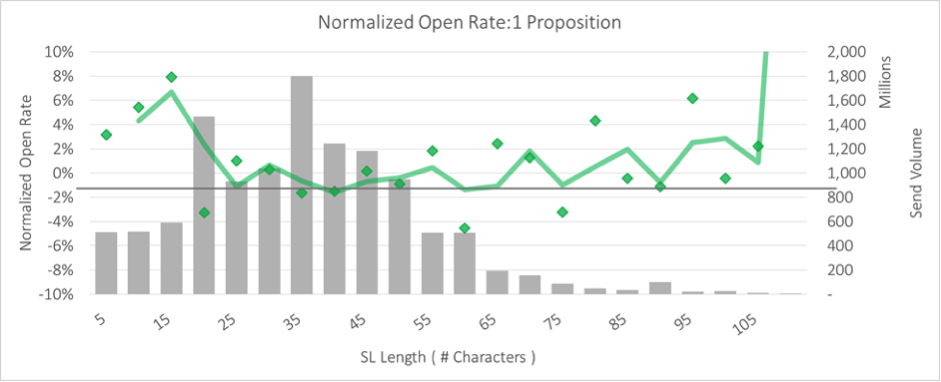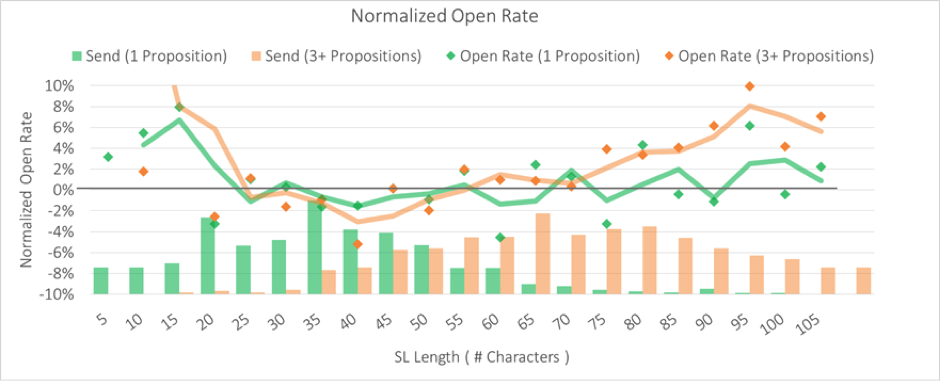Dela Quist: When it comes to subject lines does length matter?
Most of all, differences of opinion are opportunities for learning - Terry Tempest Williams
Background
As some of you may already know, Alchemy Worx the agency I founded in 2001 was recently acquired by SellUp an email marketing agency with offices in NYC and Manila, founded by Allan Levy – whom I have known for many years and respect a great deal. One of the primary reasons for doing so was to free up the time I was spending running the agency full time to spin off the software division of Alchemy Worx into a separate company. The new company, Touchstone Intelligent Marketing exists to help plug 2 significant gaps in the marketing clouds - testing and subscriber level reporting. The 1st of these Touchstone Tests a testing tool that allows you to try out any number of subject lines quickly and without burning out your customer database, is the source of the data I am about to share.
The issue: When it comes to subject lines does length matter?
What is interesting about the subject line length issue, is the question is very rarely framed in that way. It usually starts with (and there are so many examples of this it isn’t true) “evidence” that shorter subject lines (SL’s) are better than long ones. Back in 2007 almost everybody in the industry seemed to have convinced themselves that shorter (defined by the number of characters in the SL) is better. This was driven by concern that long SL would not be seen in full because longer ones got truncated by the email client. This argument or belief is in the ascendancy again driven by emergence of the smartphone as the primary device for email arbitrage. This just didn’t make sense to me. If they were right then this
SL: Zsuraurg
would always beat this
SL: 90% off all New Season Nike Apparel, iPads, and Rolex watches available online today.
To that end we looked at the data and produced a white paper on SL length first published in 2008 and updated in 2015 based on our findings. A recent piece by Econsultancy Four factors that can impact the success of email subject lines seemed to agree with one of our key findings that SL’s over 60 characters generated higher open rates than those between 21 to 60 characters even though the end might have been cut off when viewed on a smart phone.
Unsurprisingly I was asked by several people who read the article what my thoughts were and I decided it was probably a good time to revisit this issue using the huge amount of data about SL’s and their performance held within Touchstone to write this article.
Length Does Matter – and longer is (almost) always better
While it is true that this is a complicated question with no simple answers what we see in the data leads us to the conclusion that longer tends to be better than shorter if you take meaning into account and there IS a causal relationship between SL length and performance.
The only way to come to the conclusion that length has no impact on SL’s is to approach it like a machine or someone looking at a language using an alphabet they had never seen would and assign no meaning to the characters and by definition spaces in the SL like these below:
- You need to get a life :)
- [If you are still looking for hidden meaning in these SL's then you really do need to get a life and probably deserve beer and brisket
- Voted best steak restaurant in London steak, lobster, cocktail & £50 win chip, £20
- A drink for everyone
If however you focus on how 2 things – how MUCH information the SL is attempting to convey and ambiguity (the proposition unclear or requires the email to be opened to know what exactly is on offer) you come up with a very different understanding. We call every piece of information in the SL a proposition. So a single proposition unambiguous SL’ would look like this: Tennis shoes 50% off today!
An ambiguous single proposition SL would look like: Summer starts here!
Multiple proposition SL’s look like this one from GILT the masters of the multiple proposition: Last Chance for Extra 30% Off | Jonathan Simkhai, Christian Louboutin Shoes, Jetsetter Must-Haves and More Start Today at 8am ET
A few things to note:
- Multiple proposition SL ‘s contain more info and are naturally longer
- Single propositions are naturally short
- Multiple propositions are less likely to be ambiguous or misleading to the recipient
- Making a single proposition long for the sake of it is not worth the effort
- Making multiple propositions short is only possible if the recipient is very knowledgeable or the concepts are widely understood
So the fact that single propositions are usually short and multiple propositions usually longer may explain the dead zone identified in the Econsultancy article and the Alchemy Worx white paper which explains this in detail, but broadly speaking VERY short is good, but longer is generally better especially for clicks if you use the extra characters to pour more meaning into the SL.
The exception is when they are ambiguous. So very short SL’s tend to give you very high open rates because the only way the recipient can work out what to do with the email is open it. This is why SL’s like WOW! Or OOPS work so well for opens unless you do it all the time. When it comes to clicks though short ambiguous SL’s usually perform poorly and may be perceived as click bait.
What does the Touchstone data tell us?
Touchstone contains lots of data 25 billion emails sent and nearly 1 million SL’s under analysis from lots of different clients and sectors, so it’s a great source of insight about subject lines. While writing the algorithms that take the amount of information within the SL into account AS WELL as tone/emotion/length etc. was a real challenge, but it was worth it because it makes the tests results much more accurate. When we normalize the data according to each sender’s average engagement rates, here’s what we see:
This chart shows the relationship between length and open rate for all subject line types and does not take how much information into account. The gray bars are the percentage of SL’s of that length within the database. So as you can see the vast majority of SL’s sent are short. Our data matches fairly well with Econsultancy: short and long subject lines are better, and ‘medium’ subject lines perform worse.

Now this is what happens when we only take into account SL’s that contain 3 or more propositions

- The average SL is much longer and there are very few SL’s of 30 characters or less containing 3+ pieces of information
- Long SL’s are much better than short
- There are so few "less than" 30-character SLs, the margin of error on "less than" 30 character SLs is large so that big spike at the left of the chart isn’t to be trusted.
Here is what the data tells us about single proposition SL’s

Somewhat surprisingly for single propositions very short is good - after that (over 25 characters) longer is still slightly better.
Here are the 2 charts overlaid

Whichever way you look at it one thing is certain you HAVE to TEST. Decision making without testing is just guesswork. Try a subject line test today www.touchstonetest.io

 How to resolve AdBlock issue?
How to resolve AdBlock issue? 
 Dela Quist, is CMO of Alchemy Worx, the largest email marketing agency. He is a highly
Dela Quist, is CMO of Alchemy Worx, the largest email marketing agency. He is a highly